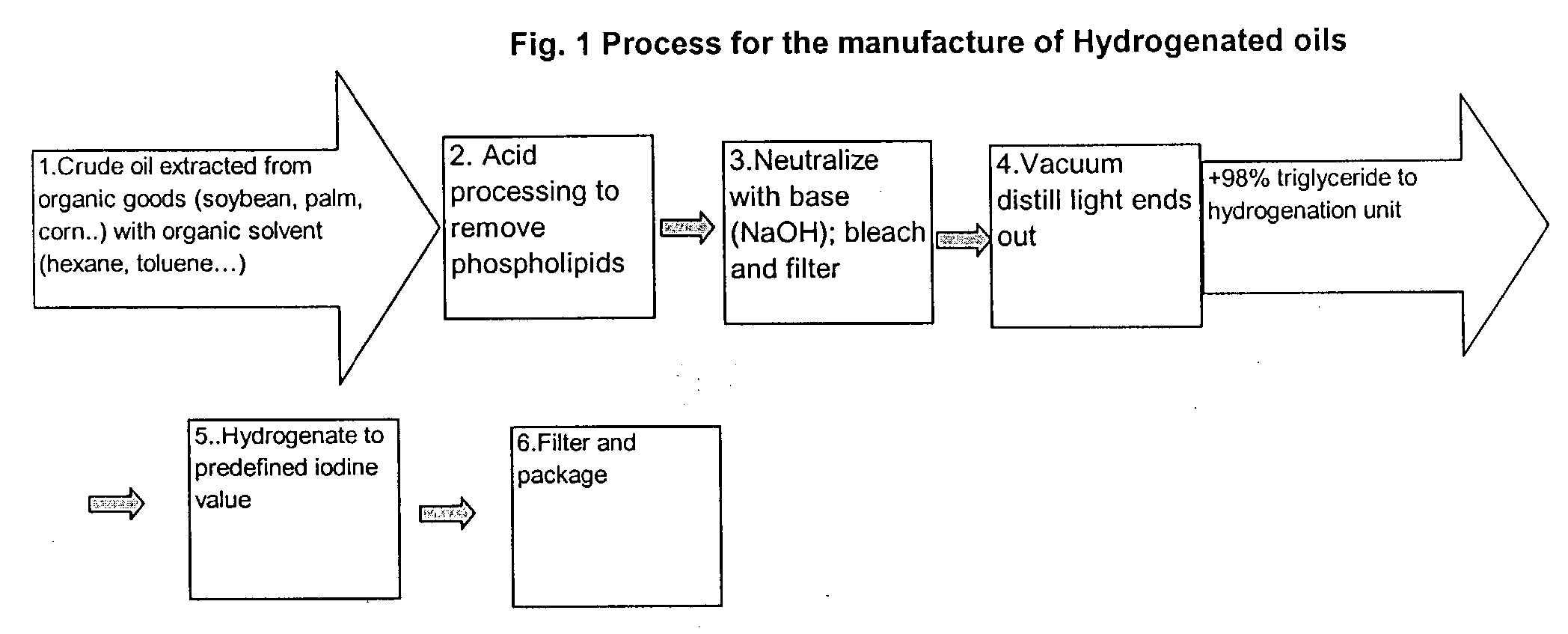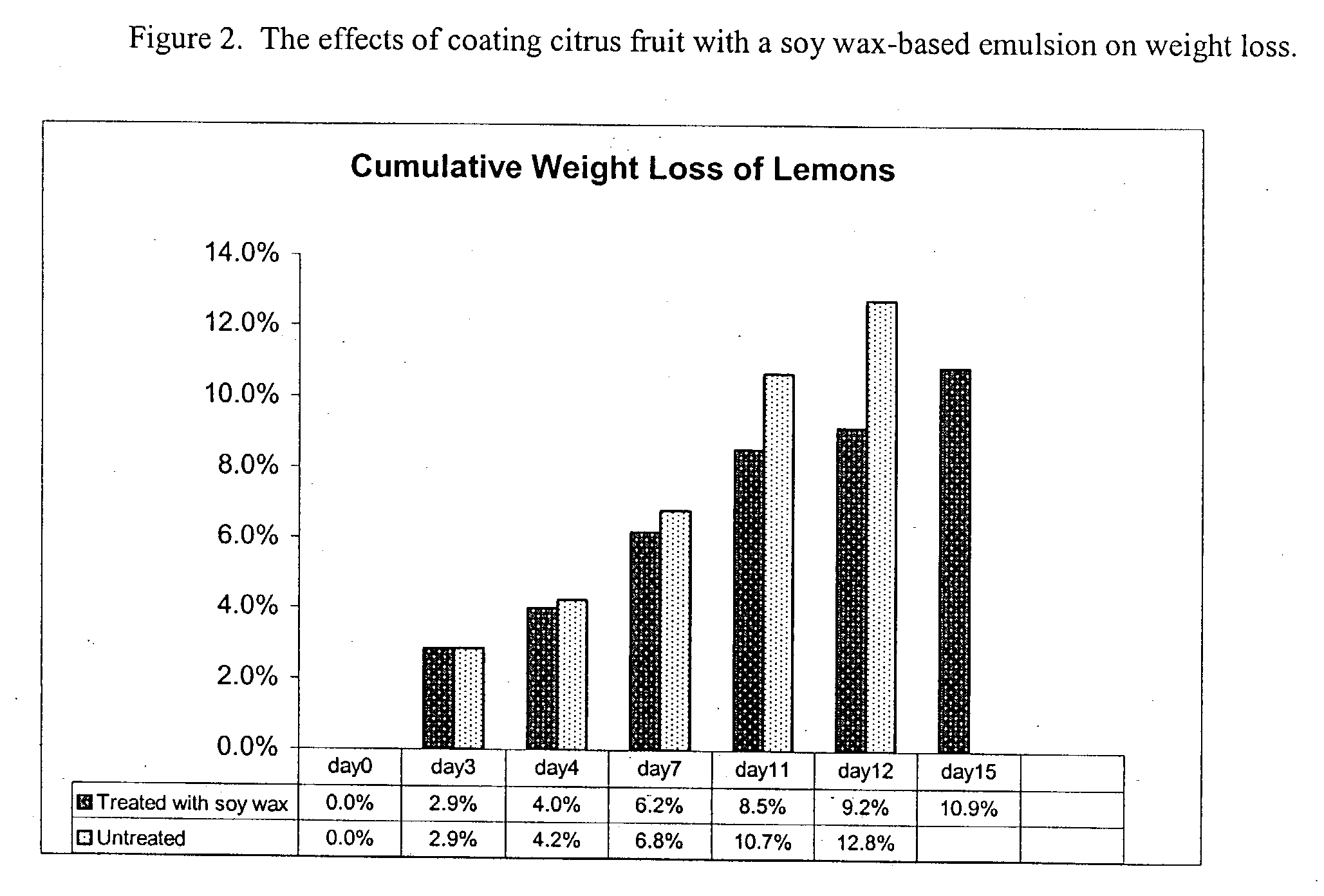Novel wax emulsion coating applications
a technology of wax emulsion and coating, applied in the field of new wax emulsion coating applications, can solve the problems of affecting the resulting particle size of the wax emulsion, affecting the health and safety of workers, and polluting the environmen
- Summary
- Abstract
- Description
- Claims
- Application Information
AI Technical Summary
Benefits of technology
Problems solved by technology
Method used
Image
Examples
example 1
Preparation and Evaluation of Nonionic Emulsions Comprising Soy Wax and Prepared Using a Homogenizer
[0068] For the purpose of illustrating the invention a nonionic emulsion was prepared utilizing Marcus Nat 155 Wax (Soybean wax). The emulsion was prepared using two atmospheric vessels, one to melt the wax and emulsifiers blend and the other to heat the water to temperature. Once melted and the water brought up to temperature, the wax-emulsifiers blend is combined with the heated water at the appropriate temperature. The mixture is homogenized using an APV / Goullin Homogenizer, an apparatus that is typically used in both the chemical and dairy industries. After homogenizing, the product can be cooled by a heat exchanger or other vessel. The homogenizer allows for more aggressive mixing and a higher solids emulsion than can be obtained using standard mixing techniques.
Ingredientsaddition (grams)Marcus NAT 155 Wax (Soy)20.0 gm30.0 gm40.0 gmNonionic Surfactant 5.0 gm 5.0 gm 5.0 gm(Tar...
example 2
Preparation and Evaluation of Cationic Emulsions Comprising Soy Wax
[0081] For the purpose of illustrating the invention a cationic emulsion was prepared utilizing Marcus Nat 155 Wax (Soy-based). The emulsion was prepared using two atmospheric vessels, one to melt the wax and emulsifiers blend and the other to heat the water to temperature. Once melted and the water brought up to temperature, the wax-emulsifiers mixture is combined together with the heated water at temperature. This technique for emulsification is commonly known to those versed in the art as a wax to water technique, and utilizes a standard mixing technique to prepare the emulsion
[0082] The reagents used were:
Marcus NAT 155 Wax (Soy)30.0 gmCationic Surfactant 7.5 gmTallow Amine Ethoxylate (TAM-5)Glacial Acetic Acid 1.9 gmWater61.6 gmFinal water charge to35% Solids
Procedures [0083] 1) Melt Marcus 155 Wax, cationic surfactant at 60-70 degrees C. [0084] 2) Heat 1st water charge to 55-65 degrees C. [0085] 3) After 1...
example 3
Preparation and Evaluation of Nonionic Emulsions Comprising Soy Wax
[0091] For the purpose of illustrating the invention a nonionic emulsion was prepared utilizing Marcus Nat 155 Wax (Soy-based). The emulsion was prepared using two atmospheric vessels, one to melt the wax and emulsifiers blend and the other to heat the water to temperature. Once melted and the water brought up to temperature, the wax-emulsifiers mixture is combined together with the heated water at temperature. As in Example 2, this technique for emulsification is commonly known to those versed in the art as a wax to water technique
[0092] Ingredients
Marcus NAT 155 Wax (Soy)20.0 gmNonionic Surfactant (Target HLB 10.5) 5.0 gmPotassium Hydroxide (45% KOH)0.05 gmWater to25% Solids
Procedures [0093] 1) Charge water and set agitation for good movement without vortex. [0094] 2) Heat water charge to 70-80 degrees C. [0095] 3) Charge Marcus NAT 155 wax. [0096] 4) Add Nonionic Surfactant. [0097] 5) Add Potassium Hydroxide ...
PUM
| Property | Measurement | Unit |
|---|---|---|
| Fraction | aaaaa | aaaaa |
| Fraction | aaaaa | aaaaa |
| Fraction | aaaaa | aaaaa |
Abstract
Description
Claims
Application Information
 Login to View More
Login to View More - R&D
- Intellectual Property
- Life Sciences
- Materials
- Tech Scout
- Unparalleled Data Quality
- Higher Quality Content
- 60% Fewer Hallucinations
Browse by: Latest US Patents, China's latest patents, Technical Efficacy Thesaurus, Application Domain, Technology Topic, Popular Technical Reports.
© 2025 PatSnap. All rights reserved.Legal|Privacy policy|Modern Slavery Act Transparency Statement|Sitemap|About US| Contact US: help@patsnap.com


